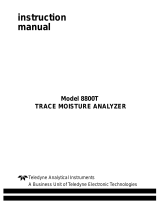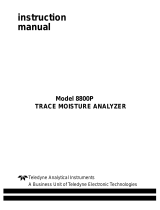Page is loading ...

Alpha Moisture Systems
Model SADPmini2 / SADPmini2-Ex
Dewpoint Hygrometer
Quick Start Guide
© Alpha Moisture Systems 2018
Alpha Moisture Systems, Alpha House, 96 City Road,
Bradford, West Yorkshire, BD8 8ES, United Kingdom
2359 SADPmini2 Quick Start Guide – Issue 1
USB connection
Power
ON/ OFF
Home key
(Home screen)
Navigation keys
Back (to
previous
Screen)
OK (confirm
selection)

Clean Gas < 10 Bar
Reduce positive pressure gas
to atmospheric pressure.
Use a needle valve at low
pressures (<10 barg) to control
flow and pressure drop.
Clean Gas > 10 Bar
Reduce positive pressure gas to
atmospheric pressure.
Use a stainless steel, low swept
volume pressure regulator at higher
pressures (>10 barg).
Gases with Particulate/ Liquid Contamination
Filter all particulate matter. Use
a coalescing filter (with drain)
for heavy hydrocarbon
condensate samples.
Hygroscopic particulate
(desiccant dust) must achieve
moisture concentration
equilibrium which may cause a
buffering effect and delay the
sample result. Hygroscopic
liquid (glycol) may accentuate
the buffering effect (as above)
and render the sensor too slow
to use.
Install the filter as close to the
sample point as practical
1. Install the sample piping system and equipment as per the required installation configuration.
NOTE: The SADPmini2 is not connected to the inlet piping system at this stage.
2. Open the sample Isolation Valve and adjust the needle valve/ regulator to allow a flow of 5-15 litres per
minute to atmosphere through to sample pipe.
3. Allow the gas to flow through the sample pipe for 2 minutes to purge the system.
4. After ensuring that the sample gas is clean and dry connect the sample pipe to the instrument.
NOTE: The orientation of the ports is not important.
5. When the sample flow is low or very dry gas is being measured connect a >20 cm pipe to the outlet port
to prevent back diffusion.
6. Allow the gas to flow through the SADPmini2 for two minutes.
7. Press the power button on the SADPmini2 and ensure that the sensor is ‘dry’.
8. Block the instrument outlet, e.g. cover with a finger and allow the Desiccant Head to extend fully.
NOTE: Do not lift the Desiccant Head manually as this will draw ambient air into the sample chamber and
produce a false reading.
9. Unblock the outlet and allow the gas to flow through the sensor.
10. The displayed reading will rise until the sensor is in equilibrium with the sample gas.
11. When the displayed reading has settled record the final reading.
12. When completed manually depress the Desiccant Head fully.
NOTE: It is important to make sure the Desiccant Head is depressed fully when the equipment is not in
use to prevent the sensor and desiccant material becoming saturated.
13. Close the sample Isolation Valve.
14. Press and hold the power button for two seconds to switch off the SADPmini2.
15. Disconnect the pipework from the SADPmini2.
DO NOT
Do not expose the sensor to
NH
3
, Hg, CO or acid gases, such
as Cl
2
and HCI, as they
chemically attack the sensor
and destroy it. Strong oxidizing
agents such as O
3
should also
be avoided
DO NOT
Do not allow the pressure in
the instrument to exceed 0.3
barg/ 4 psi
WARNING
Do not exceed a flow rate
of 20 litres per minute
Navigation Keys allow the user to access and
change the following:
• Time and Date settings
• International settings
• Dewpoint and concentration units
• Power saving options
See the user manual for details
Needle
Valve
Sample
Isolation
Process Pipe
SADPmini2
Flow
Indicator
(optional)
Regulator
Sample
Isolation
Process Pipe
Flow
Indicator
(optional)
SADPmini2
Needle Valve/
Regulator
Filter
Process Pipe
Sample
Isolation
Flow
Indicator
(optional)
SADPmini2
/


